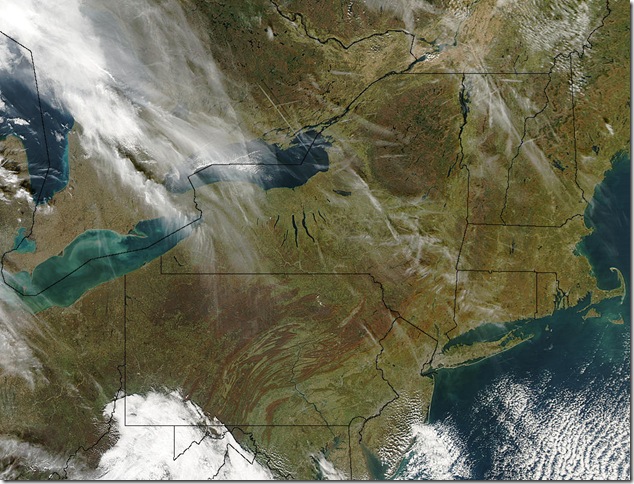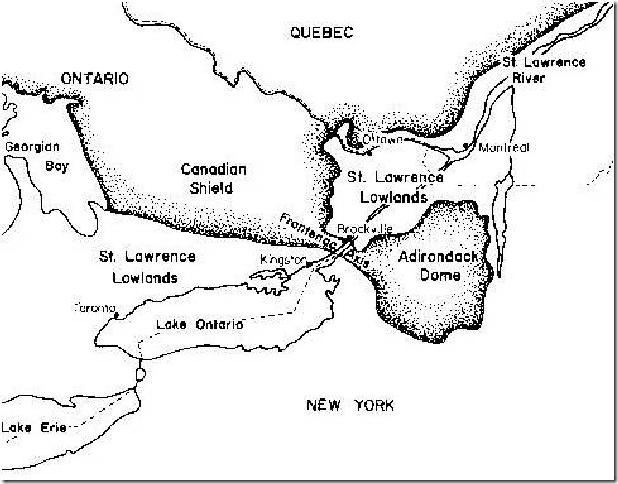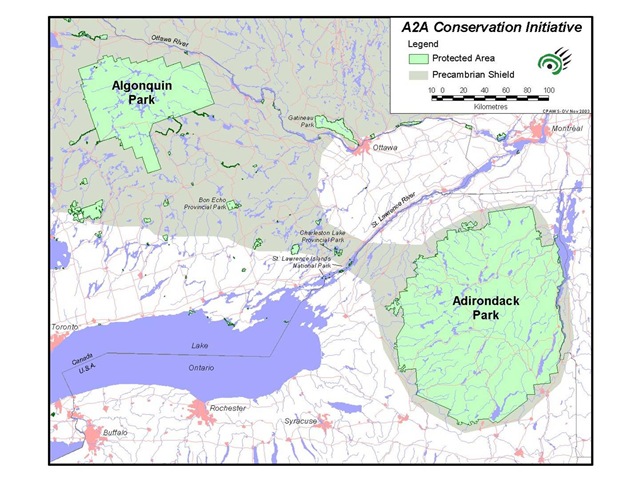Written by
Don Ross posted on November 14, 2008 21:36
HILL ISLAND - To many, the Canadian Shield is the quintessential Canadian landscape—the rugged “north”, and a land of forests and lakes. But many haven’t realized that a portion of the Shield extends southward though Ontario, and into the U.S. The Frontenac Arch, as this hourglass-shaped outlier of the Canadian Shield is known, is the ancient backbone of North America. In Mohawk tradition, this massive landform is “The Bones of the Mother”.

Photo supplied by Don Ross.
NASA image of the Northeaster United States and our region, from the altitude of 1835 kilometers.
Even to the most casual observer, the Frontenac Arch is an entirely different landscape than the remainder of southern Ontario and upper New York State. To someone driving across the land, an otherwise flat and plain countryside is suddenly interrupted by rolling hills and rugged cliffs, topped with windswept pines, and valleyed with sinewy creeks and tranquil lakes and wetlands. But about a billion years ago, this was a far more dramatic landscape. The Frontenac Arch, and the Canadian Shield, was a massive range of towering mountains. It took hundreds of millions of years for these mountains to weather down to their roots—and those basement rocks of the mountains are what we experience in this landscape today.
It happens that the lowest elevation along the Frontenac Arch lies at the east end of Lake Ontario. In fact Lake Ontario owes its existence to the Arch, which nearly impounded the lake. Through the last ice ages, glaciers bulldozed the basins for the Great Lakes. As each of the lakes filled to their brims with runoff, they overflowed the landscape on their race to the sea. In those last millennia where the land, depressed by the enormous weight of glacial ice, rebounded and rose, an early overflow of young Lake Ontario was the Oswego River. As the land rose further, tipping the lake towards the east, the lake waters finally rose far enough up the flanks of the Frontenac Arch, and began to spill between the granite hilltops. A thousand hilltops, actually the roots of the ancient mountains, became the Thousand Islands in this flooded landscape.
The greatest intersection on the continent came into being at the end of the last ice age: the intersection of the Frontenac Arch and the St. Lawrence River Valley. The Arch connects the Canadian Shield and the boreal forest to the forests of the Adirondack and Appalachian Mountains—a south to north/north to south migration route. The river valley is a route from the Great Lakes forest heartland of the continent to the forests of the Atlantic Coast. The Thousand Islands are at the very centre of that intersection, where the meeting of the great forest regions create what is proving to be the region of Canada’s greatest diversity of plant and animal communities.

These natural migration routes have also proven to be trade and migration routes for First Nations peoples. Discoveries at some archaeological sites have unearthed copper knives from the far north, shells from the southern coasts, chert for projectile points from further west and inland, and pottery types from several regions. Life at the crossroads is rich indeed.
These cultural and ecological riches were key among reasons for the designation in Canada of the Frontenac Arch Biosphere Reserve, by UNESCO. The designation celebrates the global significance of the region, where the Thousand Islands are the Biosphere’s front door. All of us who live and visit here, and especially who cherish its character in word and art share responsibility in the stewardship of one of our Earth’s most precious landscapes.
By Don Ross; Hill Island
October 2008
Don Ross is the executive director of the
Frontenac Arch Biosphere Reserve, Ivy Lea, Ontario. Don was the former Chief Naturalist for the St. Lawrence Islands National Park. He is an ecologist involved with conserving the natural and cultural heritage of the region. His book,
Discovering the Thousand Islands is a valuable resource for the region
.
Photo provided by Don Ross
The Frontenac Arch, as this hourglass-shaped outlier of the Canadian Shield
